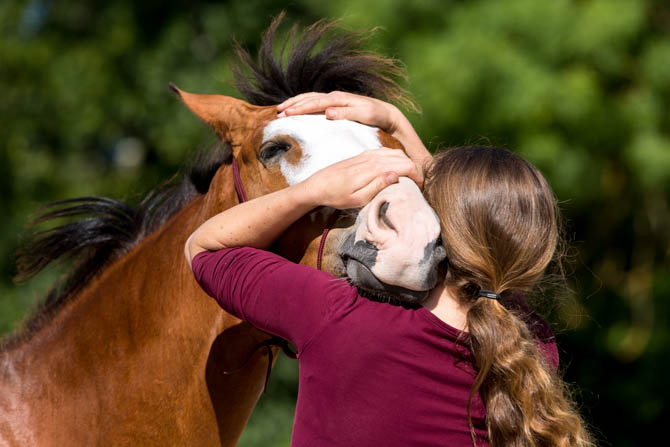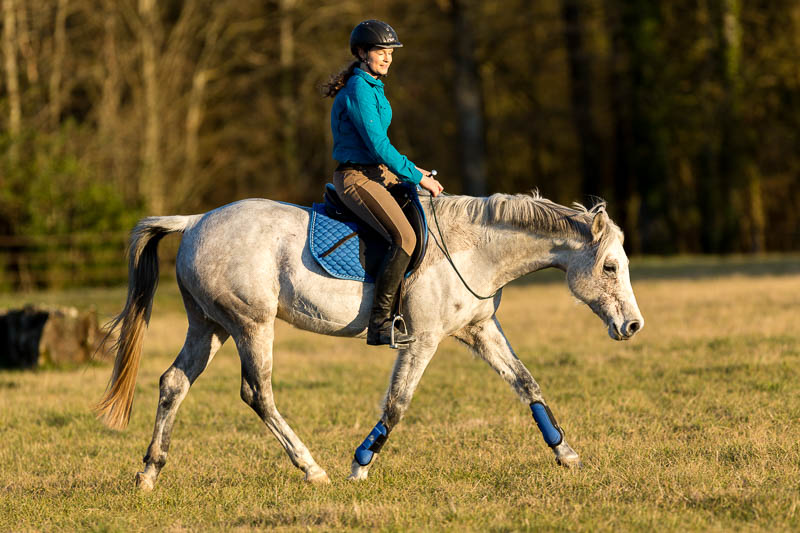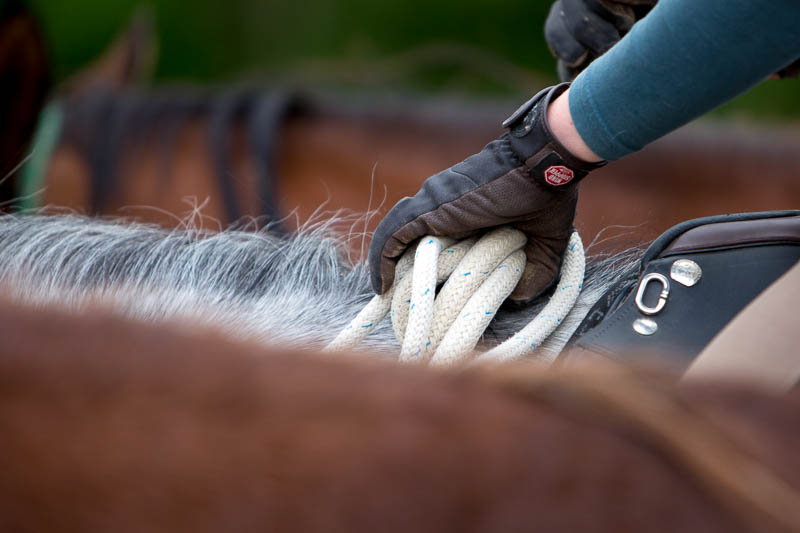Start a Mutual Dialog with your Horse [Video]
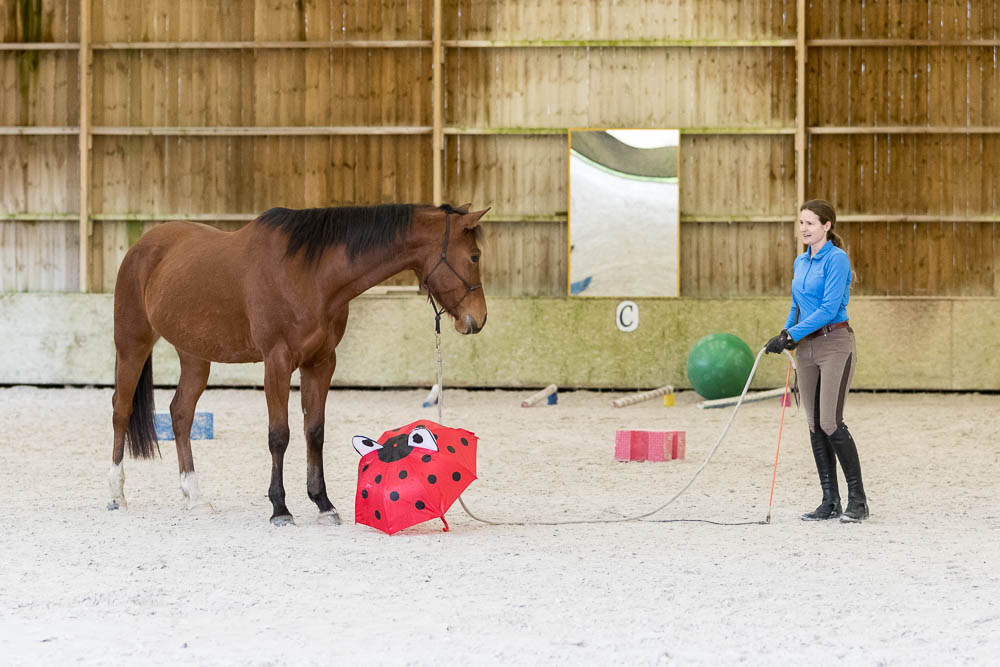
In this article, I explain in depth the first group of exercises of the "14 Preparations for a safe and respectful Colt Starting"
If your goal is to have a participating, motivated and communicating horse, this is your starting point.
When I prepare a horse to be started under saddle, I want to be sure that I can communicate with him. Otherwise, I can’t explain all the new things to the horse. My goal is to establish a question-answer communication which is going both ways. This will allow me to truly involve the horse into the process.
Maybe this sounds a bit eccentric to you, but once you learn to read a horses expressions, you will realize how much they are actually trying to talk to us. Of course, we can’t really talk like a horse. We can’t point our ears or pin them backwards.
We have to establish a commonly understood language with our horse. To achieve this, at first I like to use a game called Touch - It. Later I will ask the horse to pass over simple trail obstacles to further develop and test this communication.
Exercise # 1: The Touch-It Game
In the following video, you see me playing the Touch-It game with my 8-year-old Shagya-Arabian mare Salima. I bought her in 9.2017, she has been a broodmare until then. She was not ridden before and I started to work with her in November 2017. She is a very sensitive and easily excitable kind of horse.
When watching this video, look out for the communication happening between Salima and me.
Objective:
You can ask a horse to approach an object and investigate it - touch it. This game is based on the horse's natural curiosity. Most horses will learn it very easily. The objective is not to teach the trick of touching objects with the nose. The main objective is to establish a mutual conversation, a question/answer game.
“Communication is when two or more individuals share an idea and understand each other.” -Pat Parelli-
Ask yourself these questions:
- How does your horse answer your requests?
- Does he ask you questions back?
- How much opposition reflex/no-answers do you get? How softly does your horse respond?
- How quickly does he respond? How many misunderstandings do you have?
What will be the benefits for your horse?
- he will learn the Jackpot word when he did something right
- he will learn that he can find a solution to everything you ask of him and get a big reward!
- he will learn to put his attention on a specific task and concentrate on what you suggest
- he will learn to go to the left and right on a circle willingly when you send it to an object
- he will learn to go forwards and to stop
Ultimately this fun little game will create a positive attitude towards “work”. Wouldn’t you like your work also much more, if you knew that you could be successful with every task?
Material needed:
- Halter
- 3,7m or 7m Lead rope
- Horsemanship Stick and String
- Cone, Block, Tire, Tarp, Umbrella, Pedestal, Barrel.....
How to get started?
Place plenty of interesting objects into your arena or field. Your horse will be curious about the objects and will want to go and check them out. If your horse is very curious, you can just follow him for the first one or two.
Otherwise, you send him towards the first object. Point with your rope-hand into the direction you want your horse to go and support with the stick behind as needed.
Have a clear and strong focus - don’t let the horse distract you. You already have to know to which object you want to send your horse to before you ask your horse to go.
How to send your Horse
About 5 - 7 m before the object, start to ask your horse to stop. Pass your stick under the rope and hold it up in front of your horse. Relax your energy and breath out at the same time. If this is not enough to stop your horse in time, start shaking the rope until he stops.
Praise as soon as your horse looks at the object. Use your Jackpot-word with enthusiasm in your voice!
How to stop your Horse
Start this exercise at the walk first. As soon as your horse starts to understand, progress to the trot. This will keep the game interesting and your horse mentally engaged. You will notice that the communication between you and your horse will get easier and more fluent with each Touch-It.
Don’t look for perfection of the actual task, look for the quality of communication! Perfection will come with understanding.
What to do if things don’t go so smoothly?
1. Your horse doesn’t stop
Make sure to let your horse know IN TIME that he is supposed to stop. Be prepared and ask to stop latest 5-7 m before the object. Pass your stick under the rope and hold it up in front of your horse pointing at the object. Breath out and smile! If you keep your energy going, your horse most probably will keep going as well.
If your horse still doesn’t stop, wiggle the rope up and down until your horse stops and redirect it to the object.
Another option would be to let the horse pass and disengage his hindquarters and resend him towards the object. Maybe you will have to do this a few times. At one point the horse will think: “oh, there must be something about this object.”. He will stop and Jackpot!
2. Your horse walks in front or behind the object
Most probably you are either too close or too far from the object. Like this, the object isn’t naturally on the line of travel of your horse. Evaluate the length of your rope and the way of travel of your horse.
This exercise is the easiest when the object is on the line of travel of your horse. And remember: Don’t approach the object yourself, cause your horse to approach it and touch it. If you go close to the object yourself, you will cause your horse to move away.
3. You can’t stop your horse from stopping anymore
That's great! For a little while. Your horse really got the game. Make sure to keep the communication about stopping possible and to not turn it into a trick. Now it is the time that you give the game a new twist: We are going to stop - or not!
If you don’t change your body language and tools, your horse should keep going. If it stops anyway, use your stick rhythmically and in increasing phases until the horse gets going again. Once your horse can pass an object without stopping unasked, you can allow him to stop at the next one.
4. Your horse doesn’t go
To send you horse forward correctly, use the following phases:
Turn your energy on and point with your rope hand into the direction you want your horse to go. Then lift your stick, start to swing in rhythmically behind the horse or towards his shoulder if he is facing you.
Each swing should be a little closer to the horse. If necessary touch your horse with the stick or string- very much like a dominant horse would bite. Touch on the shoulder if the horse is facing you and on his bum to encourage him to go forward.
Stop using the stick immediately as soon as your horse moves in the desired gait and direction. Don’t forget to reward. The key is to be light and polite when the horse is light and responsive but to increase your phases until you are effective when your horse is not responding.
Horses with low energy need a reason why they should move. The horse needs to have an adequate level of respect towards your requests, but it is just as important to give them incentive when they put effort.
Incentives for a low energy horse are praise, scratches, eventually even a piece of carrot that he can find on the object. Be playful and find your horses motivation!
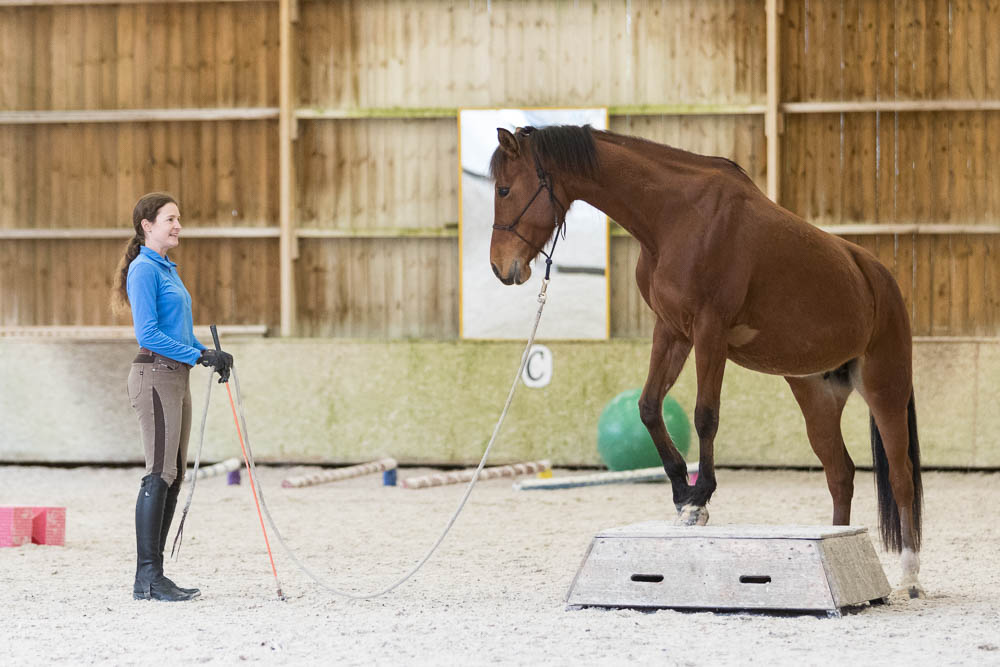
5. Your horse doesn’t stay at the walk, he wants to run!
High spirited horses might find walking very hard and boring. This doesn’t matter, they can learn it just as well from the trot. Eventually, you will have to let them trot for 1-2 circles (or more) between the touch-its.
Horses of this type will usually calm down as soon as they understand the exercise. Use rather large and obvious objects to attract more attention. The smaller the object, the more difficult it is for the horse.
Make sure to evaluate your horse's line of travel correctly so that he “lands” on the object. Praise after each successful touch it. Do not go up with them in your energy. Stay calm and focused yourself.
This can be difficult but is an important key to success. Imagine that you are a solid rock in the middle of a wild river.
Challenge yourself!
Once you get the hang of this fun little game, challenge yourself and your horse.
Can you….
- do it with the 7 m rope?
- do it from a canter?
- ask your horse to touch a very small object like the lid of a bucket?
- ask your horse to touch with one foot?
Exercise # 2: Passing Easy Obstacles
Young horses have quick minds. That's why we should keep things progressive and interesting for them. This will help us to keep their interest and attention with us. To test and further develop the communication you created with your horse through the Touch-It Game, ask it pass over simple trail obstacles.
This gives you the chance to create even more successful situations for your horse - he will get even more motivated and interested. Once I start to ride the horse, I can use these obstacles to add purpose to riding.
Most young horses don’t see the purpose of carrying a rider and these obstacles will help the horse to understand their new job.
Objective:
You can ask your horse to pass over a tarp, jump a little obstacle, stand on the pedestal and trot over some ground poles. Your horse follows your suggestion willingly and with understanding. He starts to be proud of his new skills.
Material needed:
- Rope halter
- 3,7 m lead rope, better 7 m
- Stick and String
I like to use at least these 3 Obstacles:
- trotting poles - distance according to your horse
- a big blue plastic tarp
- a 60 cm jump
Additionally, if available, I will use a Pedestal, an L-Shape corridor, a wooden bridge. You can be creative.
Benefits for your horse:
- The more things your horse knows to do, the smarter he will feel about himself
- your horse's self-confidence will grow
- he will get smarter
- braver
- more athletic
- and learn to look out for where he puts his feet.
Later, when you introduce cinch and saddle to your horse, you can use the obstacles to test your horse's acceptance of the new equipment. Many horses think that they can’t move normally anymore once cinched up. Getting them to pass over these easy obstacles helps them to realise that everything is still alright.
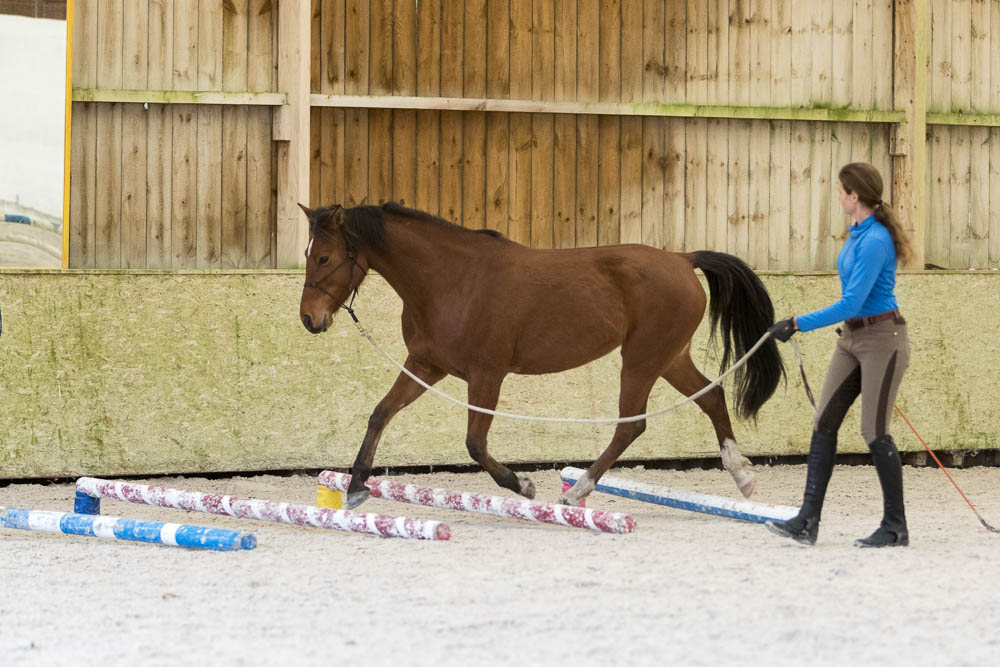
How to start:
The Touch-It game is a perfect preparation. Start with playing Touch-It with all the obstacles you want your horse to pass. Especially with things like the plastic tarp, the pedestal or a jump, many horses are a little afraid off at first.
Simply ask your horse to only touch and investigate them at first. Don’t give in to the temptation to push your horse over the obstacle. Most horses will have the idea to walk over these “scary” obstacles all by themselves after a few repetitions.
If you push a horse forward right in front of an obstacle, you will create a claustrophobic situation for the horse and cause it to react with opposition reflex. Approach and retreat is the key for the unconfident horse.
To give you an example, let me explain the jump and the tarp obstacles:
The jump
Start with a very low jump - maybe just 20 - 30 cm. Send your horse to the obstacle and stop it before to play Touch-it. Your horse has to stay straight and centred in front of the jump.
Don’t allow your horse to touch the obstacle with its feet! It could pull a pole down, hurt his legs and lose confidence. Send your horse off to the other direction and repeat the touch it.
Once your horse stood straight and centred in front of the jump from both sides, go to the next step. Have your horse trot on a circle and send it behind the jump, then between you and the jump. Do the same from the other side. Bring it back to you and reward.
Send it out again and repeat the same sequence, but finish off with asking it to pass the jump. Praise big time when your horse jumps!
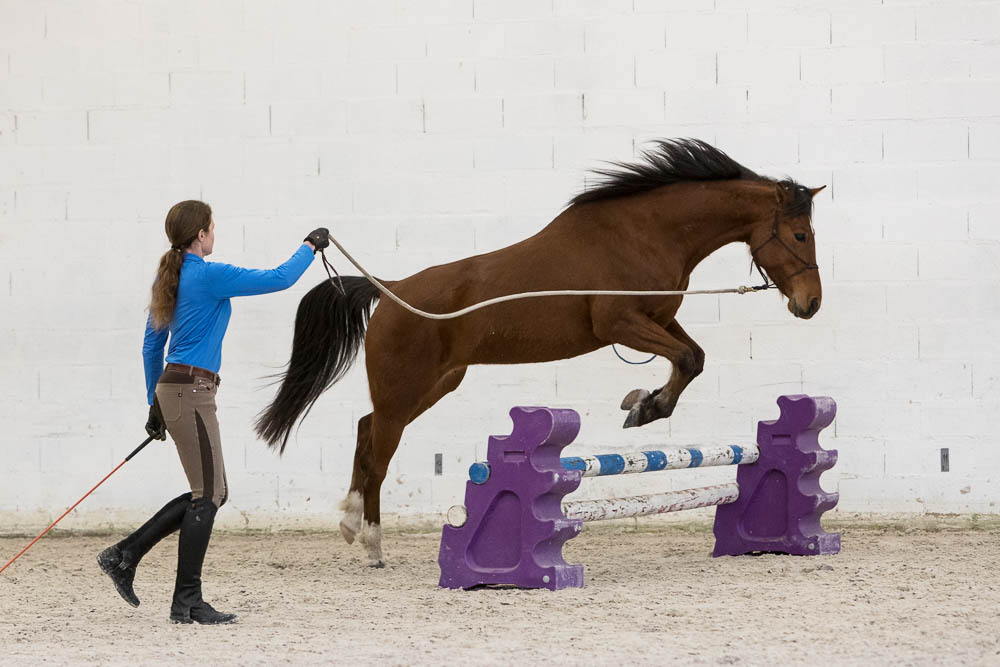
In case your horse stops, that’s ok. Probably he still lacks a bit of confidence. Don’t push him, send him off to the other direction and repeat the sequence of before. Confidence is priority number one. At one point your horse will take a leap of faith and go for the jump.
If you have a lazy horse, don’t ask it to come back to you right after the jump. Ask it to speed up instead - only then reward.
Some horses tend to destroy every obstacle and don’t pay attention to their feet. If you have a horse like this, build a very solid looking jump. The best would be to use natural obstacles like a big log.
Watch this video to see how I deal with my mare Salima, who is quite afraid of jumping and a real Drama-Queen.
The tarp:
In case your horse is really afraid of the tarp, ignore it for a few session. Simply put it in the arena and let the horse get used to its presence. As the first challenge, ask your horse to touch the tarp with his nose.
Your horse might already stop a few meters before the tarp or try to avoid it by pushing on you.
If your horse stops: Don’t push it forwards, you will only increase his fear. Let it watch for a few seconds, then send it to the other side. With each time, he will get a little closer to the tarp.
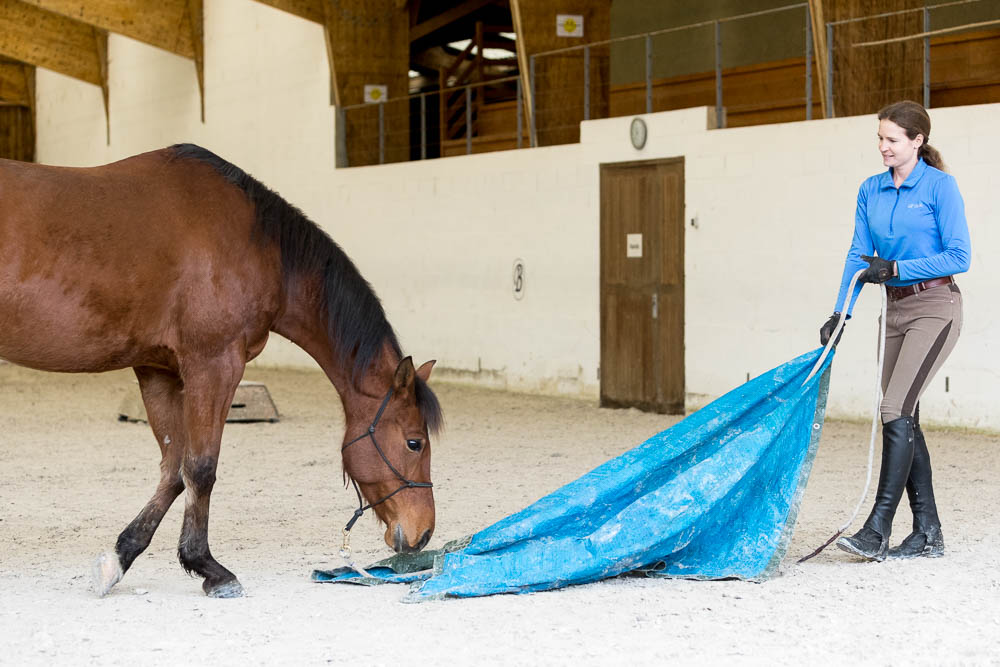
If your horse pushes on you and tries to run between you and the tarp:
This is a no-go situation, stop your horse and defend your space with assertiveness. Your horse needs to learn to confront his fears and to trust and respect you when dealing with scary things.
When he runs between you and the tarp, he is acting on his flight instinct. Interrupt the behaviour and set it up new. If your horse shows behaviour like this, it is better to show him the tarp several times within a session just for 2-3 minutes and then retreat and do easier things. With each repetition, your horse's confidence will grow.
Once your horse can touch the tarp with its nose easily, you can encourage your horse to put his front feet. Soon he will discover that the tarp is not eating horse feet and walk over it. Praise your horse for his bravery!
It might seem easy and simple to us, but for a lot of horses, it is a big deal to trust a human when they are afraid.
Your horse just got a lot braver and his trust in you when dealing with scary situation grew big time!
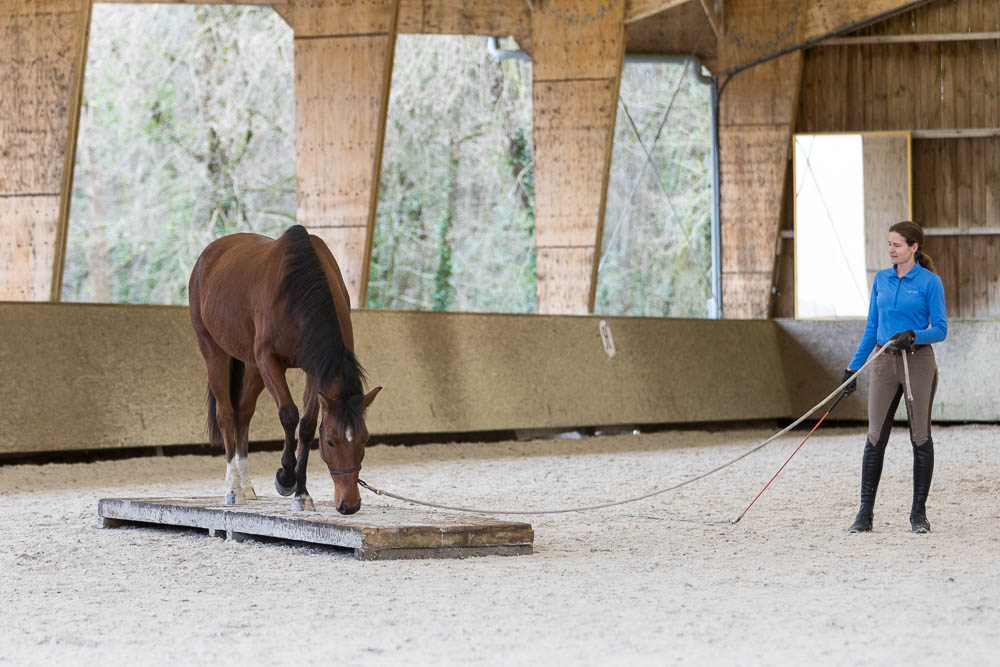
Challenge yourself
Can you:
- ask your horse to trot over the tarp
- ask your horse to jump from a canter
- ask your horse to jump 2 obstacles in a row
- ask your horse to trot over 4 ground poles 2 x from the right, change direction and 2 times from the left
- ask your horse put 2 feet on the pedestal
Conclusion
The better you can communicate with your horse, the more confident and respectful your horse will be. You will start to recognise and be able to interpret your horse's body language better and better.
Your horse's motivation, confidence and enthusiasm will grow and he will enjoy spending time with you. Soon you will have the feeling that you can “talk” with your horse and that he is “talking” back.
This is the feeling that makes me so addicted to horses, I love it. I am sure this is also your reason why you have a horse: You want to spend a good time with your friend and have the feeling that he enjoys it as much as you do.
Related Articles






